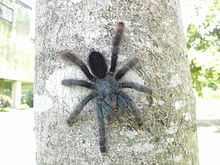Pinktoe tarantula
| Pinktoe tarantula | |
|---|---|
 |
|
| Scientific classification | |
| Kingdom: | Animalia |
| Phylum: | Arthropoda |
| Subphylum: | Chelicerata |
| Class: | Arachnida |
| Order: | Araneae |
| Infraorder: | Mygalomorphae |
| Family: | Theraphosidae |
| Genus: | Avicularia |
| Species: | A. avicularia |
| Binomial name | |
|
Avicularia avicularia (Linnaeus, 1758) |
|
| Synonyms | |
|
|
Avicularia avicularia, sometimes called the pinktoe tarantula, is a species of tarantula native from Costa Rica to Brazil and the southern Caribbean. This species is sometimes called the Guyana pinktoe, common pinktoe, or South American pinktoe.
The mature pinktoe tarantula has a dark-colored body and pinkish feet, hence its name. Juvenile specimens, however, have pinkish bodies and dark-colored feet. Pinktoe tarantulas undergo a reversal in their coloration as they approach adulthood at 4–5 years. They are sit-and-wait predators, with limited activity.
Being arboreal species, they require a relatively tall habitat with plenty of climbing space in captivity. They require a lot of moisture, along with ample ventilation to prevent molds from developing.
They are known to lure in their victims through the process of stationization, the act of remaining in a trance-like state until moment of attack. A full grown pinktoe tarantula can grow up to six inches in length. Their first reaction when threatened is usually to run or leap away, but they may react defensively if provoked (as with any theraphosid). Their venom is considered mild, even compared to other new-world tarantulas.
Although this species is often rumoured to be communal, housing them in groups will almost inevitably lead to cannibalism over time.
...
Wikipedia
